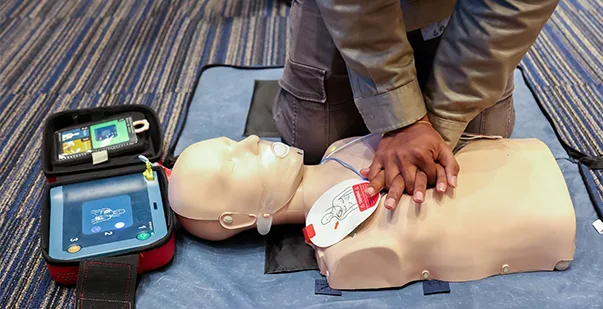
Last Updated on: October 15, 2024
Table of Contents:
Most cardiac arrests and other overwhelming medical incidents like drowning occur outside of the hospital—at home, in public, or even at the workplace. When you find yourself in such emergencies, the key is to give the victim the best chance of survival by starting CPR as quickly as possible. A study has found that bystander CPR increases the victim’s odds of survival by 28%. In this blog, we will walk you through the goal of CPR, its importance, and how it helps you save someone’s life. Let’s get started!
CPR (cardiopulmonary resuscitation) is a life-saving technique that combines chest compressions and rescue breaths. It is administered to mimic the heart’s natural pumping action, maintaining blood circulation throughout the body when the heart fails to beat or circulate blood effectively. CPR sustains the supply of oxygen-rich blood to vital organs by administering external chest compressions until advanced medical treatment is available. The key components of CPR include:
Read More: What Does CPR Stand For
The main goal of CPR is to restore blood flow and breathing in a victim whose heart has stopped. The primary objectives of this life-saving technique are to:
Remember, performing CPR on victims is a temporary measure and should not be considered a substitute for advanced medical care. It is also important to sign up for proper CPR training and certification before attempting CPR on a victim.
There are various emergencies where performing CPR is required, from heart attacks and drowning to drug overdoses. If you find a victim collapsed or unconscious, CPR may be needed. Here are some situations where you need to administer CPR:
The goal of CPR is based on the understanding of the body’s need for adequate oxygen to function properly and the role of the heart in pumping oxygen-rich blood throughout the body. When the victim’s heart stops beating effectively or they stop breathing, the delivery of oxygen to vital organs is compromised. CPR helps bridge this gap by providing external assistance to circulate oxygenated blood.
When someone is choking or has gone into cardiac arrest, time is of the essence. To prevent further damage, air circulation and clearance of clogged airways should be enabled to preserve life. By administering CPR, you can respond confidently and appropriately until professional help arrives. As a result, you become an essential link in the chain of survival, thereby improving the chances of a positive outcome.
During cardiac arrest, the heart ceases to circulate blood to the brain and other vital organs. If CPR is not performed within three minutes, the victim will suffer permanent brain damage. As time progresses without intervention, the chances of survival decrease significantly, with minimal chances after approximately 20 minutes. CPR plays a vital role in maintaining blood circulation, potentially avoiding severe harm to the victim.
CPR techniques may vary depending on the age of the victim in need of medical assistance. CPR training classes cover specific techniques and considerations for administering CPR to adults, children, and infants. Learning a comprehensive approach ensures you are prepared to assist victims of all ages during cardiac emergencies.
Administering prompt CPR to someone experiencing sudden cardiac arrest significantly increases their chances of survival and recovery. Life-saving techniques play a crucial role in restoring healthy breathing patterns and blood circulation, facilitating the victim’s overall recovery. In some circumstances, effective CPR can enable the victim to lead a life with minimal adverse effects from the condition.
Learning CPR not only equips you with practical skills but also instills confidence in your ability to handle emergencies effectively. With proper training and education, you will feel prepared and capable of taking appropriate action when it matters most. This improved confidence makes you a valuable resource in high-pressure scenarios.
Learning CPR fosters personal and professional development. You gain the ability to respond effectively in emergencies, demonstrating responsibility, compassion, and leadership qualities. CPR training is also a valuable addition to your career. For instance, some professional or volunteer positions require CPR certification.
Read More: How CPR Certification Can Boost Your Resume
CPR is part of the emergency cardiac care system designed to save lives. The technique must be performed within four to six minutes after the cessation of breathing or heartbeat to prevent permanent brain damage or death. Below are the steps involved in performing CPR:
The goal of CPR is to save lives by maintaining adequate blood circulation and oxygen supply during cardiac arrest. Whether you are a concerned individual or a health professional, enrolling in proper CPR training empowers you with the knowledge and skills to administer this life-saving technique when it matters most. As we navigate the uncertainties of life, remember that knowledge and preparedness can help you make a difference in emergencies. The call to action is simple: Learn CPR, empower yourself, and become a source of hope for those in need.